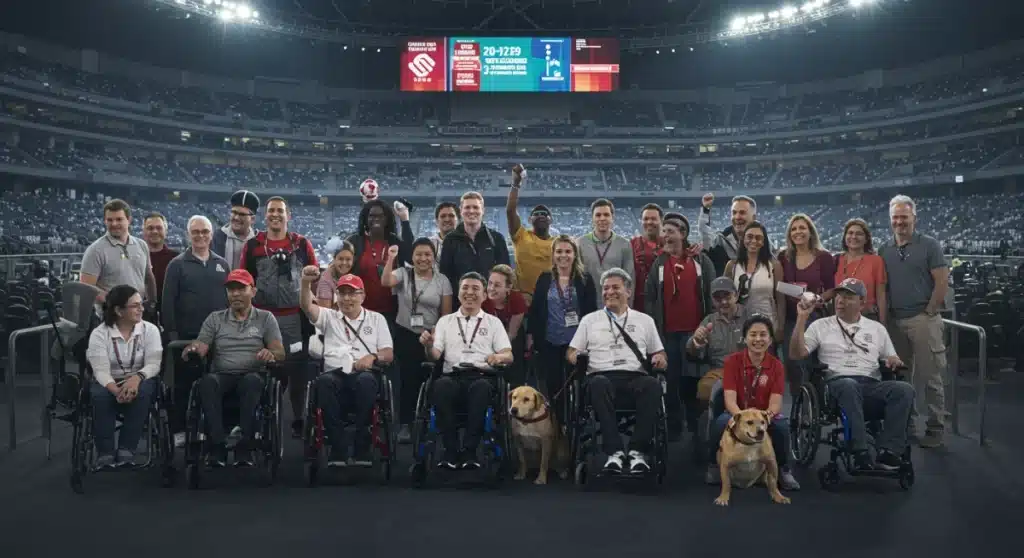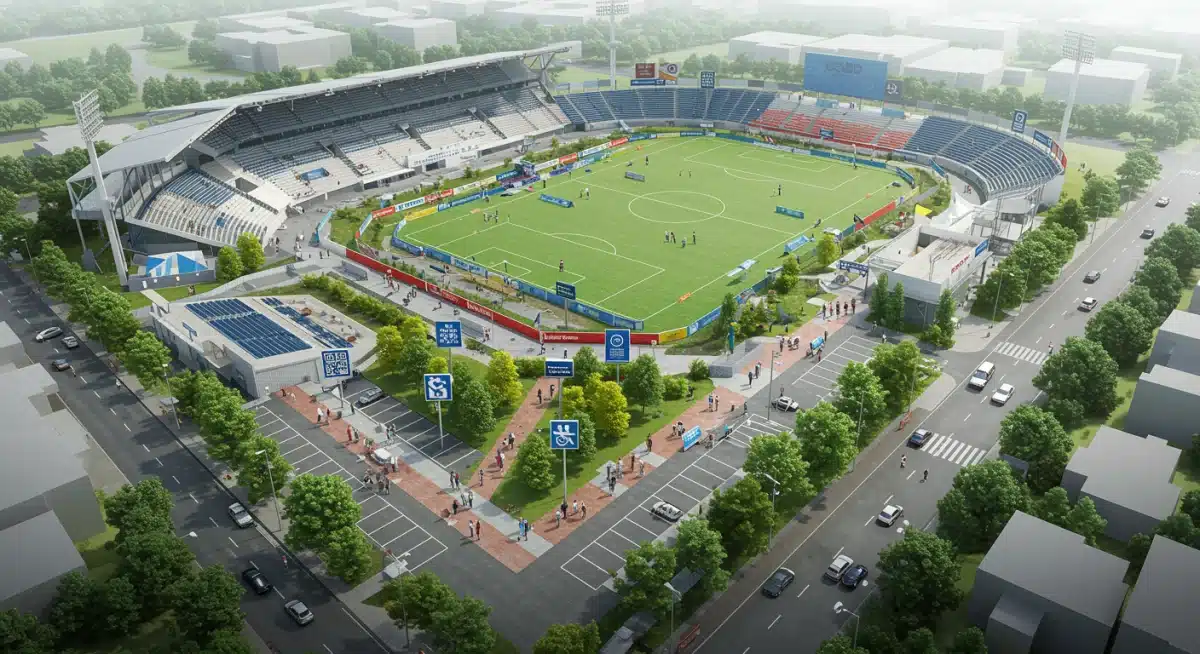Sports Event Accessibility 2025: Compliance & Inclusion

Anúncios
Current trends in sports event accessibility for 2025 emphasize achieving 100% compliance with regulations and enhancing inclusion for all attendees through comprehensive practical solutions and recent technological updates, ensuring an equitable experience for everyone.
As the world of sports continues to evolve, so does the imperative to ensure that every fan, athlete, and participant can engage fully and equitably. The focus on current trends in sports event accessibility for 2025 is not merely about meeting legal requirements but about fostering a truly inclusive environment where barriers are dismantled, and opportunities are amplified for all attendees.
Anúncios
Understanding the Mandate: ADA and Beyond
The Americans with Disabilities Act (ADA) has long served as the cornerstone of accessibility legislation in the United States, dictating standards for physical and programmatic access. However, for 2025, the conversation around sports event accessibility extends significantly beyond basic ADA compliance, moving towards a proactive, universal design approach.
This shift acknowledges that true inclusion requires anticipating diverse needs rather than simply reacting to them. It involves integrating accessibility from the initial planning stages, considering not just physical mobility but also sensory, cognitive, and communicative requirements. The goal is to create environments where accessibility is seamless and invisible, benefiting everyone.
Anúncios
Evolving Legal Frameworks and Best Practices
While the ADA provides foundational guidelines, state and local regulations often introduce additional stipulations, and international standards influence global events. Event organizers must remain vigilant about these evolving legal landscapes to ensure comprehensive compliance.
- Regular legal audits: Conducting periodic reviews of facilities and practices against current and upcoming accessibility laws.
- Staff training: Implementing mandatory, ongoing training programs for all event personnel on accessibility best practices and disability etiquette.
- Consultation with disability advocates: Engaging directly with individuals with disabilities and advocacy groups to gain firsthand insights and feedback.
Beyond legal mandates, best practices in 2025 emphasize a ‘design for all’ philosophy. This means considering how every aspect of an event, from ticketing to transportation, concessions, and spectator areas, can be made inherently accessible. It’s about moving from a checklist mentality to a culture of genuine inclusion, ensuring that accessibility is woven into the very fabric of the event experience.
In conclusion, the mandate for sports event accessibility in 2025 transcends mere compliance. It necessitates a deep understanding of evolving legal frameworks and a commitment to universal design principles, ensuring that inclusivity is a core component of every event’s planning and execution.
Technological Innovations Driving Inclusion
Technology is a powerful enabler for enhancing accessibility at sports events, offering innovative solutions that address a wide spectrum of needs. From advanced navigational tools to immersive sensory experiences, digital advancements are reshaping how individuals with disabilities interact with and enjoy live sports.
The integration of smart technologies allows for personalized experiences, breaking down barriers that traditional event setups might inadvertently create. These innovations are not just about convenience; they are about empowerment, giving attendees greater autonomy and control over their event experience.
Smart Navigation and Wayfinding
Navigating large, often crowded, sports venues can be challenging for anyone, but especially for individuals with mobility or visual impairments. Modern solutions leverage GPS, indoor positioning systems, and augmented reality to provide real-time, accessible guidance.
- Accessible mobile apps: Features include audio descriptions of routes, accessible restroom locations, and real-time crowd density information.
- Beacons and RFID technology: Providing proximity-based information and assistance, guiding attendees to their seats or amenities.
- Interactive digital maps: Offering customizable views that highlight accessible pathways, elevators, and sensory-friendly zones.
These tools not only simplify navigation but also reduce anxiety and enhance independence for attendees. They transform potentially overwhelming environments into manageable, user-friendly spaces, ensuring everyone can find their way with confidence.
Furthermore, wearable technologies are emerging as critical aids. Smart glasses can provide visual descriptions for visually impaired attendees, while haptic feedback devices can offer directional cues. The convergence of these technologies creates a multi-modal approach to wayfinding, catering to diverse sensory needs.
In summary, technological innovations are pivotal in advancing sports event accessibility for 2025. They offer practical, scalable solutions that transform the event experience, making it more intuitive, enjoyable, and inclusive for all.
Physical Infrastructure: Beyond Ramps and Elevators
While fundamental elements like ramps, elevators, and accessible restrooms remain crucial, the focus for 2025 in sports event accessibility is on a more holistic and integrated approach to physical infrastructure. This means designing venues from the ground up with universal access in mind, ensuring every space is usable by everyone, regardless of ability.
It’s about creating an environment where accessibility features are not add-ons but integral components of the design, blending seamlessly with the overall aesthetic and functionality of the venue. This prevents a segregated feel and promotes a truly unified experience for all attendees.
Universal Design Principles in Stadiums
Applying universal design to sports venues encompasses everything from seating arrangements to concession stands and emergency exits. The goal is to eliminate physical barriers and foster an environment that is welcoming and functional for individuals with diverse needs.
- Flexible seating options: Providing not just dedicated wheelchair spaces but also companion seating, transfer seats, and accessible viewing platforms with unobstructed sightlines.
- Accessible concession stands: Lowered counters, clear menu displays with high contrast and large fonts, and staff trained in assistance.
- Sensory-friendly spaces: Designated quiet rooms or zones for individuals with sensory sensitivities, offering a calm retreat from overstimulation.
Beyond these, considerations extend to the quality of accessible pathways, ensuring surfaces are smooth, slip-resistant, and free from obstacles. Adequate lighting, clear signage with tactile information, and accessible water fountains are also essential components of a universally designed venue.
Moreover, emergency preparedness plans must explicitly address the needs of individuals with disabilities, ensuring clear evacuation routes, trained personnel, and accessible assembly points. This comprehensive approach to physical infrastructure ensures safety and comfort for all attendees during high-stakes events.
Ultimately, a truly accessible physical infrastructure goes beyond compliance, reflecting a genuine commitment to ensuring every attendee can navigate, engage with, and enjoy the sports event without encountering unnecessary barriers.
Enhancing the Fan Experience for All
The core of sports event accessibility in 2025 is not just about physical access, but about enriching the overall fan experience for every individual. This means considering how to make the emotional, social, and interactive aspects of an event equally enjoyable and meaningful for people with diverse abilities.
It’s about moving beyond simply ‘allowing’ attendance to actively ‘engaging’ and ‘including’ everyone in the excitement and community that sports events foster. This involves a multi-faceted approach, integrating various services and programs designed to cater to specific needs while benefiting the broader audience.
Inclusive Communication and Engagement
Effective communication is paramount to an inclusive fan experience. This involves ensuring information is available in multiple accessible formats and that communication channels are open and responsive to diverse needs.
- Real-time captioning and audio descriptions: Providing live captions for announcements and visual descriptions of the game action for individuals with hearing or visual impairments.
- Sign language interpreters: Offering interpreters for key event moments, ceremonies, and public announcements.
- Accessible websites and ticketing platforms: Ensuring online platforms meet WCAG (Web Content Accessibility Guidelines) standards for ease of use by individuals using assistive technologies.
Beyond formal communication, fostering a welcoming atmosphere involves staff who are not only trained in accessibility protocols but also possess genuine empathy and a proactive approach to assisting attendees. This human element is irreplaceable in creating a truly inclusive environment.
Furthermore, interactive elements like accessible fan zones, meet-and-greets, and digital engagement opportunities should be designed to be inclusive. This might involve tactile exhibits for visually impaired fans or quiet spaces for those with sensory sensitivities to participate in activities at their own pace.

In conclusion, enhancing the fan experience for all requires a deliberate and thoughtful approach to inclusive communication, empathetic personnel, and universally designed engagement opportunities. This ensures every attendee feels valued and fully part of the sports spectacle.
Staff Training and Awareness Programs
The most advanced infrastructure and technology can fall short if event staff lack the proper training and awareness regarding accessibility. For 2025, comprehensive staff training programs are recognized as a critical component of ensuring exceptional sports event accessibility.
These programs go beyond basic customer service, delving into specific disability etiquette, understanding diverse needs, and practical skills for assisting attendees. An informed and empathetic staff can transform a potentially challenging experience into a positive and memorable one for individuals with disabilities.
Developing Comprehensive Training Modules
Effective training covers a wide range of topics, ensuring all staff members, from security personnel to ushers, concession workers, and medical teams, are equipped to provide appropriate assistance.
- Disability etiquette: Teaching respectful and appropriate interactions with individuals with various disabilities.
- Assistance protocols: Practical guidance on assisting with mobility devices, guiding visually impaired individuals, and communicating with deaf or hard-of-hearing attendees.
- Emergency procedures: Specific training on assisting individuals with disabilities during emergencies and evacuations.
Training should also include modules on recognizing and responding to hidden disabilities, such as autism or PTSD, providing staff with the tools to offer sensitive and effective support. Role-playing scenarios can be particularly effective in preparing staff for real-world situations.
Moreover, cultural competency training is vital, as accessibility needs can intersect with cultural backgrounds. This ensures a nuanced and respectful approach to all attendees. Regular refresher courses and feedback mechanisms are also crucial for continuous improvement and to keep staff updated on the latest accessibility best practices.
Ultimately, investing in robust staff training and awareness programs is an investment in the overall quality and inclusivity of sports events. It empowers staff to be proactive advocates for accessibility, creating a welcoming atmosphere for everyone.
Measuring Impact and Continuous Improvement
Ensuring 100% compliance and enhancing inclusion in sports event accessibility is an ongoing journey, not a one-time achievement. For 2025, a critical trend is the emphasis on robust measurement of impact and a commitment to continuous improvement, driven by feedback and data.
This involves establishing clear metrics, gathering diverse feedback, and using insights to refine strategies and implement further enhancements. A proactive approach to evaluation ensures that accessibility efforts remain relevant, effective, and truly responsive to the needs of all attendees.
Feedback Mechanisms and Data Analysis
Collecting feedback from individuals with disabilities is paramount. Their lived experiences provide invaluable insights that go beyond compliance checklists and highlight areas for genuine improvement.
- Post-event surveys: Specifically designed surveys for attendees with disabilities, gathering feedback on various accessibility aspects.
- Dedicated accessibility hotlines/email: Providing direct channels for attendees to report issues or offer suggestions during and after events.
- Focus groups and advisory committees: Engaging with disability advocacy groups and individuals to discuss proposed changes and gather in-depth qualitative feedback.
Beyond direct feedback, event organizers should analyze data related to accessible seating usage, assistance requests, and incident reports to identify patterns and areas needing attention. This quantitative data, combined with qualitative feedback, provides a comprehensive picture of accessibility performance.
The insights gained from these measurement efforts should then directly inform future planning and implementation. This iterative process of feedback, analysis, and adjustment ensures that accessibility initiatives are not static but evolve dynamically to meet changing needs and expectations. It signals a genuine commitment to ongoing inclusion, positioning events as leaders in accessibility.
In conclusion, measuring impact and committing to continuous improvement are essential for maintaining high standards in sports event accessibility. By actively seeking and acting upon feedback, event organizers can ensure their efforts lead to increasingly inclusive and enjoyable experiences for everyone.
| Key Trend | Brief Description |
|---|---|
| Universal Design | Integrating accessibility from initial planning, not as an afterthought, for all event aspects. |
| Technological Integration | Utilizing smart apps, AI, and digital tools for navigation, communication, and personalized experiences. |
| Enhanced Fan Experience | Focus on accessible communication, sensory-friendly spaces, and engaging all attendees beyond physical access. |
| Continuous Improvement | Employing feedback mechanisms and data analysis to continually refine and improve accessibility features. |
Frequently Asked Questions About Sports Event Accessibility
Universal design in sports events means planning and constructing venues and experiences to be inherently accessible to all people, regardless of age, ability, or disability. It aims to eliminate the need for specialized design by creating solutions that work for everyone from the outset, rather than adding accessibility features as an afterthought.
Technology can greatly assist visually impaired attendees through features like audio descriptions of live action and surrounding environments, accessible navigation apps with voice guidance, and tactile maps. Wearable devices and smart glasses can also offer real-time visual information converted into audio or haptic feedback, enhancing independence.
Staff training is crucial for successful accessibility, as well-trained personnel can provide informed, empathetic assistance. Training covers disability etiquette, practical help with mobility aids, communication techniques for diverse needs, and emergency procedures. This ensures staff are proactive and capable of creating a welcoming, inclusive atmosphere for all attendees.
Sensory-friendly spaces are designated quiet areas within a sports venue designed to provide a calm retreat for individuals with sensory sensitivities, such as those with autism. These zones typically have reduced noise, softer lighting, and fewer crowds, offering a safe environment for attendees to decompress from overstimulation during a bustling event.
Organizers measure impact through various methods, including post-event surveys specifically for attendees with disabilities, direct feedback channels like hotlines, and engaging with disability advisory committees. They also analyze data on accessible seating usage and assistance requests. This information helps identify successes and areas for continuous improvement in accessibility efforts.
Conclusion
The journey toward fully accessible sports events in 2025 is characterized by a profound shift from mere compliance to genuine inclusion. By embracing universal design, leveraging cutting-edge technology, thoughtfully designing physical spaces, empowering staff through comprehensive training, and committing to continuous improvement through feedback, event organizers are setting new benchmarks. These efforts ensure that the thrill, community, and inspiration of sports are truly available and enjoyable for every single attendee, fostering a more equitable and welcoming environment for all.





